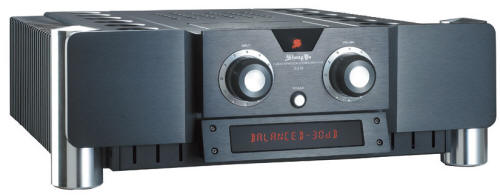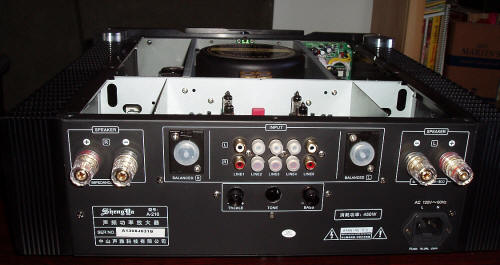
You are reading the older HTML site
Positive Feedback ISSUE
42march/april 2009
shengya
A-216 hybrid integrated amplifier
as reviewed by Kent Johnson
|
KENT JOHNSON'S SYSTEM
LOUDSPEAKERS
ELECTRONICS
SOURCES
CABLES
ACCESSORIES SECOND SYSTEM
LOUDSPEAKERS
ELECTRONICS
SOURCE
CABLES
ACCESSORIES
|
If the name Shengya is an unfamiliar one, don't feel badly. They are a Chinese manufacturer of high quality tube and solid-state audio products. For some years they have been building OEM equipment that is sold here in North America, but they are now entering the market here with equipment made under their own name; equipment not based on any of the OEM designs. Grant Fidelity of Canada is importing this equipment as well as offering repair and warranty service for it.
The Shengya product line being imported is comprised of various amplifiers, preamplifier, and integrateds, but this review concerns itself with the least expensive, but to my mind the most interesting, of the integrated amplifiers, the hybrid A-216. While this equipment is new to North America, all of it has been available in China for some time. Shengya began building hybrid and solid-state components back in the early 1990s when most Chinese audio equipment was still entirely tube-based.
Description
If there is one common factor uniting all of the Chinese-made audio equipment that I have encountered, it is weight. The A-216 is no exception. Weighing in at 46 pounds, just getting it out of the box will test the condition of your lower back muscles.
While the styling of the A-216 will probably not win any awards, it certainly qualifies as functional and well-conceived. The quality of the Shengya's fit and finish, on the other hand, is irreproachable. The A-216 is made from machined aluminum panels with the exception of the back and bottom; everything fits with impressive precision. It stands on three feet, the front two of which are, again, machined; the third foot sits near the back of the chassis.
The front fascia of the amplifier consists of a 12mm thick aluminum panel sculpted in the center to accommodate the amplifier's smaller control panel.
Toward the top of the control panel are two large machined knobs. The left one selects one of the six line Inputs—five unbalanced and one balanced. The right knob controls the Volume. Neither the input nor volume knobs actually control mechanical switches. All switching and volume control is done electronically. The A-216 has no phono section and no tape in/out jacks.

Between the two knobs is the On/Off button. Turning the amp on causes the Shengya logo at the top of the panel to flash for about 20 seconds and then, if everything is functioning properly, glow a steady red. Below the On/Off switch is the display panel. It reads out the selected input and the volume level in red lettering. Volume is adjustable in 1dB increments from -99 to 0dB, each change clearly displayed. As a reviewer, the ability to return precisely to a previous volume level makes me want to weep with joy.
The rear of the amplifier has five sets of gold-plated, good quality RCA input jacks and one pair of XLR jacks. There is an IEC AC socket. I used my PS Audio Prelude AC cord with the A-216.
The A-216 also has Bass and Treble controls. These are located on the rear of the amp along with a switch that determines whether they are in or out of the circuitry. I tried these controls and they make fairly extreme adjustments to the sound; they are subtle only within a very small segment of their range. While I did my listening with the tone controls out of the circuitry, I think offering these controls is basically a good idea as long as a listener is careful. They are located where they won't be constantly tampered with. Once an adjustment is made, for example to adjust for room acoustics, a listener probably won't need to touch them again.
The sides of the A-216 consist of substantial, nicely rounded cooling fins that won't slice your hands up like some I have encountered. These fins never got more than mildly warm no matter how loudly the amplifier was played or how long it was on. It appears to me that the A-216 is overbuilt for its rated power. The only place on the A-216 that ever got discernibly warm was right over the 4 input tubes.
These tubes are Chinese military quality 6N16 miniature tubes. They are soldered into the circuit board (the A-216 is fully balanced) and have a life expectancy of 200,000 hours. They are expected to last the life of the amplifier. If the A-216 is listened to for an average of 5 hours per day, the tubes will last just over 109 years, assuming my math is correct.
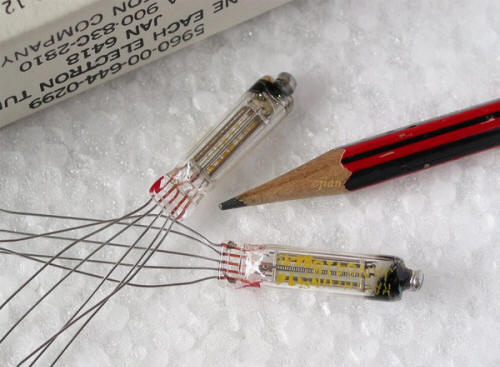
I really like the small all-metal remote control that comes with the Shengya. It is only 1.25 inches wide, about .75 of an inch thick, and 7 inches long. Its twelve buttons occupy the sensor end, leaving room for your hand and placing the volume buttons right where your thumb can find them. There are also buttons for the line inputs, Balance, Mute, and Gain.
Playing with the Balance Control was interesting as it changes the balance in 1dB increments. It is actually possible to hear a change of only 1dB with careful listening. What struck me was how obvious a change of 2dB was; it is not as subtle as I would have expected.
Pressing the Gain button toggles between 0dB and -8dB settings. If you have source components with widely differing output levels, the -8dB setting will allow the louder source to be brought closer in volume to the quieter. I used only one source, so I listened at the 0dB setting.
The manual that comes with the A-216 is minimal. While it does discuss all the amplifier's connections and controls, both on the amp and remote, it does not even mention that the amplifier has tubes.
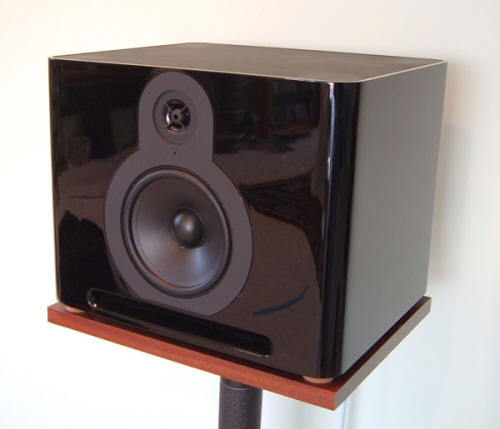
Listening with the Guru M10 loudspeakers
I connected the A-216 to the output of my Cullen DAC and initially to the Swedish-made GURU QM10 speakers that I was also reviewing. I let this combination break-in for over 100 hours before doing any critical listening.
The Shengya and GURU speakers were delightful together, each exhibiting the other's strengths. The remarkable bass output of the GURU speakers was reproduced with effortless ease by the A-216's ample power output.
Voices whether male or female, unaffected to operatic, were all realistic and lovely. The reproduction of instruments as diverse as flutes, oboes, cymbals, bells, and high frequency percussive instruments was accomplished with realistic sheen and air. Soundstages were recreated with first-rate width. It was only soundstage depth that was less than exemplary, a function of the GURU's positioning requirements. I'm summarizing here as I have discussed this combination in more detail in the GURU review. To put it briefly, the Shengya and GURU meshed extremely well together.
Listening with the Quad 21L2 loudspeakers
Since my Quad 21L2 speakers were still in my listening room, I next listened to the A-216 with these standards. Coming on the heels of the GURU speakers, it was evident that the Quads were slightly less dynamic and detailed than the Swedish speakers but in other respects were far more similar than different
Tierney Sutton's rendition of "Accustomed to His Face" from her CD, Something Cool (Telarc CD-83548) had knocked me out with the Grant Fidelity A-534B 300B amplifier. While the A-216 clearly did not sound as harmonically rich, it got the limpid quality of her voice right in a way that made recollections of the A-534B unavoidable.
The Quad speakers harmonized extremely well with the Shengya. The 21L2's reasonable efficiency (88dB) allowed the A-216 to effortlessly and instantly recreate the dynamics and frequency of every signal it was fed. Bass and treble information was reproduced with the same level of excellence as the midrange.
I was very impressed with the Shengya's soundstaging capabilities, which are as good as I have heard in my listening room. With every speaker I listened to, the Shengya recreated wide, deep, and realistic performance venues. The impact of transient attacks and their decay into silence was also very impressive.
I did some measuring, both subjective and objective, while the Quads were connected to the A-216. Subjectively, I listened to the Quads for any noise. With my SACD player stopped and my ear to the drivers, the speakers were absolutely silent. I think a bat would have to be brought in to detect any noise from this amp.
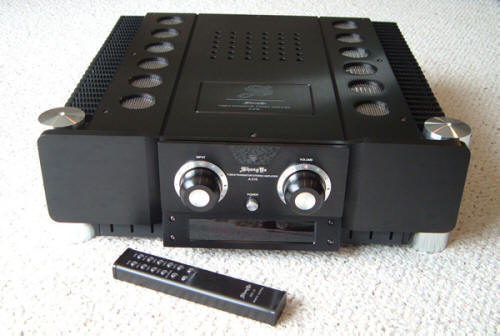
Volume changes via either the remote or volume knob were silent as well. Changing inputs resulted in very small, hardly intrusive, "tick" sounds as relays switched within the amplifier.
Objectively, I did some measuring of the amplifier's output at several volume settings. (Not something I needed to do; I was just curious.) I used the Stereophile Test CD's 1000 Hz tone. The channel balance of the A-216 was within .002 Volts at every volume setting that I tried, essentially perfect.
I listened to Sinead O'Connor's Am I Not Your Girl for the first time in a while. Her voice was somewhat airier and breathier than I remembered it. I realized for the first time (I'm slow.) that she is channeling Marilyn Monroe on several songs. This is obvious on "I Want to be Loved by You" and more subtle on "Bewitched, Bothered, and Bewildered." Her voice was extremely sexy and when she gets to the line "Horizontally speaking…" impressively dirty. It was wonderful. (Chrysalis D 100139)
John Coltrane for Lovers sounded gorgeous through the Quads. If there has ever been a more perfect voice for ballad singing than Johnny Hartman's, I cannot image whose it would be. His voice on "My One and Only Love" steals attention completely away from Coltrane's saxophone. (Impulse 314 549 361-2)
After about 200 hours of listening to the Shengya amplifier and my Quads, I returned to Sinead and found her voice had gained some additional body without losing any of its sexiness. Coltrane's saxophone revealed the air moving through it with greater clarity. Reverberations within the recording space were more evident as well. The extra time had clearly improved the Shengya's ability to reveal low-level detail.
I really enjoyed listening with the Quads but the time had come to confront the question that had caused me to request the A-216 for review in the first place: how close does its sound come to an all tube system? Are tubes in the input section enough?
Bringing in the Magneplanar MG1.6s
I have been looking forward to getting back to the 1.6s. The whole point of having a reference is to maintain some stability, even predictability, in the sound of your system. Stay away too long and your bases for comparison suffer. After spending considerable time with the Xavian and GURU speakers over the past several months, it was time for me to get back to my regular set up.
I connected the MG1.6s to the A-216 with Alpha Core Goertz MI2 speaker cables. I located the 1.6s where the Xavians had been, slightly behind and further apart than I had previously had them. After a few small adjustments to toe-in, everything was sounding very good.
After months of listening to small monitor speakers, the Magneplanars looked absolutely immense; it took me a while to get used to their presence. Fortunately, their soundstaging abilities undermine their size and your brain pays more attention to where it hears things than where it sees them. Initially, the bass of the MG1.6s was loose and boomy. In my experience even well broken-in equipment needs some run-in if it has sat unused for any length of time. Within several hours, the sound of the 1.6s was back to normal.
I did all my listening to the Shengya/Magneplanar combination with SACDs. I then replaced the A-216 with my all-tube Dodd/Rogue combination and did further listening. Here is a summary of what I heard.
Anonymous 4 always brings a natural sense of the performing acoustic to their recordings. On American Angels (Harmonia Mundi HMU 807326), their lovely a cappella voices reverberate within a large space. With the A-216, there was a feeling that, as their voices rose in volume, they were on the verge of becoming shrill. This never actually happened, however. With the Rogue amp, there was no sense of this impending possibility. Both set ups did room reverberation and soundstage width equally well. The Shengya delineated the soundstage depth far better; depth was more amorphous with the Rogue.
Diana Krall's Love Scenes (Impulse B0002841-36) sounded wonderful with both amplifiers. With careful listening, however, the all-tube set up imparted a small improvement in both richness and body to her voice. It was as if her voice originated in her throat instead of just her mouth. This was subtle to be sure and did not affect my enjoyment of this SACD with either amp. In all other respects, instrumental and soundstaging, there was really nothing to choose between the two set ups.
I also listened to a sampler SACD that had come with a recent copy of Gramophone. It is all classical music and contains both vocal and instrumental performances. On these excerpts, the Shengya again offered a clearer sense of depth, better separation between instruments and singers, and better impact from percussion instruments. The Rogue offered the better sense of reality where voices were concerned. These were, again, very subtle distinctions.
Conclusions
The Shengya A-216 has considerable strengths. It is extremely well built, absolutely quiet, powerful, offers balanced inputs, has sophisticated controls, and is maintenance free. Economically, it eliminates the need for tube replacement—at least for any of us currently alive, uses less electricity than a tube amp, and costs only $1850. And it sounds incredibly good, too.
In several respects, the Shengya outperformed my normal set up. Depending upon the recording, it defined soundstage depth with more accuracy, separated individual instruments and vocalists better, and reproduced transient attacks in more detail.
The sole criticism that I can make regarding its performance is that it does not quite offer the same tangible realism when reproducing the human voice as my all-tube amplifier combination, which new, cost about three times as much.
Of course, I am approaching the A-216 from the standpoint of a tube person for whom its vocal qualities are of supreme importance. From a more balanced stand point, it does everything so well that there is really nothing to criticize and everything to praise, the more so when its price is considered.
The Shengya A-216 amplifier does come extraordinarily close to offering the best of both worlds—the sonic virtues of an all-tube system with the convenience and strengths of solid state amplification. I could not only live with the A-216, I would enjoy every moment of doing so. Kent Johnson
A-216 integrated
Retail: $1850
Specifications
● Frequency response: 20Hz - 20kHz±0.5dB
● Power output: 150W + 150W (8 ohms) RMS
● THD: ≤0.1% (1 kHz, 1W)
● Input sensitivity: 380mV
● S/N: 85dB
● Input Impedance: 47k ohms
● Size: 18"W x 6"H x 19"D
● Weight: 21 kg / 46 lbs
● Remote control included
● Warranty: Two years parts and labor
web address: www.grantfidelity.com

